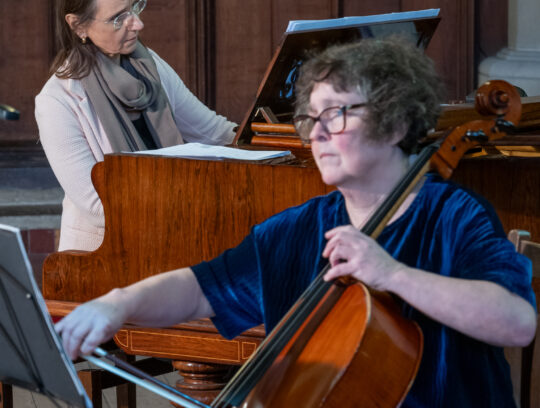
Cello and piano lunchtime recital
Date: Wednesday 19th March 2025
Time: 1pm
Venue: Lion Walk Church
Location: Lion Walk Precinct, Colchester, Essex CO1 1LX
Artists: Veronica Henderson - cello
Elizabeth Mucha - piano

J.S. Bach (1685 – 1750)
Sonata for Viola Da Gamba, in G Maj, BWV 1027
Adagio
Allegro ma non tanto
Andante
Allegro moderato
Felix Mendelssohn (1809 – 1847)
Lied ohne Worte Op 109
Neil McKay (1947 – 2023)
Scena for cello and piano
Marie Dare (1902 – 1976)
Hebridean Suite
Isle Of Jura (Two Impressions)
- Summer Sea
- The Paps of Jura
The Blue Lochan
A Day Dream
Shieling Song
A Fisherman’s Song
Cellist Veronica Henderson and I are excited to be performing in the historic town of Colchester with a programme which takes the audience on a journey from Leipzig of the 1730/40s to Scotland in the 1980s.
We open our programme with the first sonata in G major BWV 1027 composed for viola da gamba and harpsichord by Johann Sebastian Bach. Of the three sonatas composed for this combination this is the only one for which the autograph score has survived. This has enabled musicologists to date the sonatas to the late 1730s or early 1740 which were the years Bach lived and worked in Leipzig. The sonata was intended to be performed at Café Zimmermann, a coffee house in the main square in Leipzig by members of the Collegium Musicum.
The opening Adagio is a stately yet intimate conversation between the two instruments. The second movement opens with a lively melody which is later inverted giving it a more sombre feel. The music then journeys through various keys before returning to the safety of G major. The third movement in E minor is the most intense movement of this composition: the steady rhythmic pulse and the slow changing arpeggios create an ethereal sense of stillness. The lively fourth movement, underpinned by the dance rhythm of a bourrée, brings us back to earth.
The next work in the programme is by the German composer Felix Mendelssohn who acts as the bridge between Bach and the Scottish pieces which follow. Mendelssohn played a significant role in reviving Bach’s music and his visit to Scotland in 1829 inspired him to write “The Hebrides Overture” and the Scottish Symphony. The one and only “Song without Words” which Mendelssohn composed for the cello is also important as it was composed for Lisa Cristiani, a female cellist which at the time was very rare.
“Scena” by Scottish composer Neil McKay very much lives up to its name: not only is it a powerful and dramatic piece of music but it has also has quite a history. McKay composed this one movement work in 1982 for Mike Spring, recently of Hyperion records, who gave me his copy sometime in the late ‘80s. Hearing about McKay’s death I mentioned that I had the score of “Scena”, and only then did it transpire that Mike thought that the manuscript had been lost in a fire. It was a ‘lost’ work that had been hiding in plain view amongst my music scores for nearly 40 years!
The last work in our programme is by the Scottish composer and cellist, Marie Dare. Born in Newport-on-Tay in Fife, she studied at the Guildhall School of Music and later in Paris. Between the wars she was active on the music scene in London and in 1938 formed the Marie Dare String Quartet. After serving in the Women’s Royal Navy Service in WWII, she became principal cellist of the Reid Orchestra in Edinburgh and was, for many years, a member of the Scottish Trio with Wight Henderson and Horace Fellows. She also taught cello at the Royal Scottish Academy of Music. Most of her compositions are for small chamber ensembles, many featuring the cello.
The “Hebridean Suite” is made up of six short pieces. The first two “Summer Sea’ and “The Paps of Jura” were composed in 1947 after a summer holiday on the Isle of Jura. She later added a further four compositions to the set which continue the theme of musically depicting aspects of highland life and the Scottish landscape.
